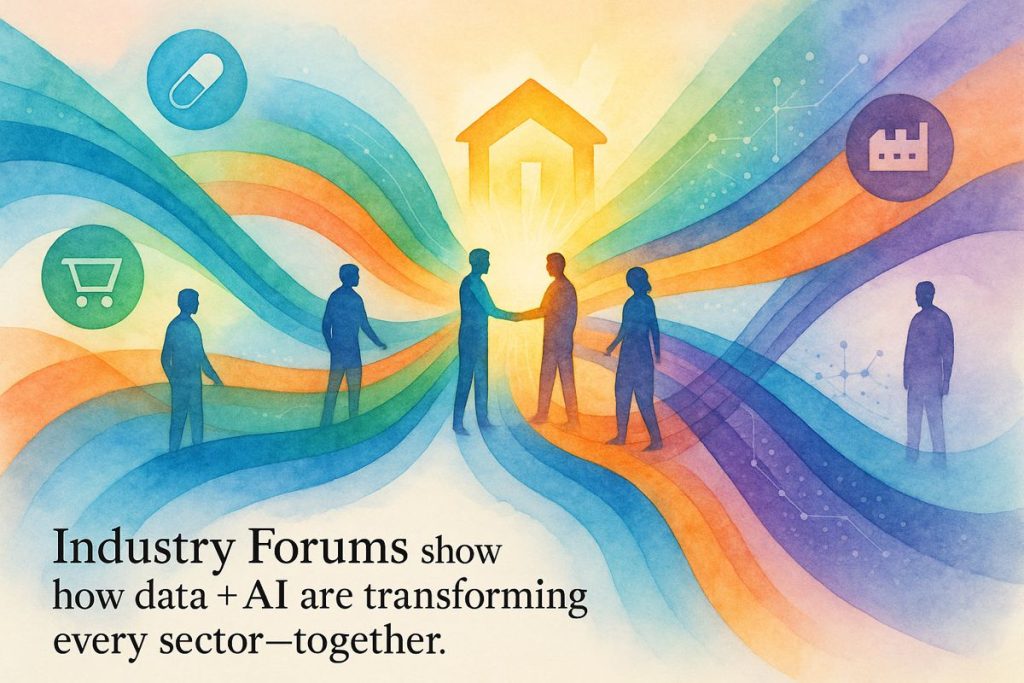The Databricks Data + AI Summit 2024 was buzzing with excitement, hosting over 16,000 people in person and 40,000 online. The big news was the launch of twelve Industry Forums, where real companies like Walmart and Lexmark shared honest stories about using data and AI to solve real problems. Databricks introduced new Lakehouse architectures to help everyone organize their messy data, and Genie, a cool tool that lets anyone ask questions in plain language and get instant answers. The event was all about real-life wins, hard lessons, and making data tools easier for everyone to use.
What were the key highlights of the Databricks Data + AI Summit 2024?
The Databricks Data + AI Summit 2024 featured twelve new Industry Forums, sector-specific tracks showcasing real-world data and AI use cases. Highlights included Databricks Lakehouse reference architectures, Walmart’s retail analytics, Lexmark’s manufacturing transformation, and the launch of Genie, a natural language AI/BI interface for streamlined analytics.
Some conferences splash color over the same old canvas, but the 2024 Databricks Data + AI Summit? It turned the whole gallery upside down. With a thrum of anticipation and the caffeinated energy of over 16,000 on-site and 40,000 virtual attendees, the Moscone Center buzzed like a hive of data-obsessed bees. (And yes, you could practically taste the burnt espresso in the air.) But the real star this year? The debut of twelve Industry Forums—sector-specific tracks tailored like bespoke suits for domains from life sciences to manufacturing. It all felt a bit like witnessing a palimpsest in progress: engraving new meaning over the old scribbles of conference convention.
Industry Forums: From Abstract to Hyper-Specific
I’ll admit, when Databricks teased “Industry Forums,” I rolled my eyes—was this just another buzzword parade? But the moment I ducked into the Retail & Consumer Goods track, skepticism gave way to—bam!—genuine curiosity. Walmart’s team strode up and, with surgical precision, dissected their journey to self-service assortment and space analytics. We’re not talking vague “innovations” here: they cited exact throughput numbers and, in a whisper of pride, described how they shaved hours off decision cycles that used to drag on for days.
Meanwhile, Rivian’s engineers detailed machine learning models for EV charging optimization, their diagrams punctuated by the low hum of audience murmurs. It’s one thing to read a whitepaper; it’s another to see the human fingerprints—quick sketches on napkins, a missed semicolon, the awkward pause when someone admits, “We hit a wall with data drift last quarter.” I had to stop and ask myself: why do most events gloss over the bruises acquired en route to success?
The Industry Forums also shone a hyperspectral spotlight on cross-vendor synergy. Integrations between Databricks Lakehouse, Salesforce, and SAP weren’t just theoretical. Take the SAP connector—one presenter described the sound of their servers ramping up for high-volume ETL jobs as a “jet engine at takeoff,” and the metaphor stuck with me. These weren’t isolated silos; they were pieces of an ever-evolving digital ecosystem.
For those who want to plunge into the specifics, the Retail & Consumer Goods Industry Forum session is worth a deeper read.
Manufacturing’s Moment: Lexmark’s Unlikely Pivot
Switching gears, the Manufacturing Industry Forum delivered its own flavor of surprise. Lexmark—yes, the printer folks—walked us through a transformation that, honestly, I’d underestimated. Once merely a customer of Databricks, Lexmark morphed into a full-blown strategic partner, channeling their in-house IoT prowess into a platform for others. During their talk, Sudhir Mehta sketched out a reference architecture that looked (and sounded) as dense as a Tolstoy novel, but with more lambda functions than existential crises. I felt a pang of envy—the way Lexmark retooled their data flows made my own past data migration headaches seem almost quaint.
It wasn’t all triumphalism, though. Demetrios Karathanasis openly recounted a time they misconfigured a Spark cluster, triggering a chain reaction of cost overruns. That sharp mix of embarrassment and determination? I know it well. But here’s the kicker: Lexmark’s willingness to air their laundry (dirty and clean) left the audience oddly uplifted.
Curious about their journey? Lexmark’s knowledge hub is a trove of war stories and diagrams.
Lakehouse Reference Architecture: The Skeleton Key
There’s a phrase I overheard in the hallway—“Every data architecture is a palimpsest.” It stuck with me. The Summit’s reference architectures for the Databricks Lakehouse were the backbone of almost every session, and for good reason. Modular, federated, and open, they offered a blueprint for unifying mismatched data sources, from streaming sensor logs to ancient SAP tables. (Raise your hand if you’ve ever cursed at a CSV from 2002.)
The breakdown was disciplined: ETL orchestration via Lakehouse Federation, batch and streaming ingestion with Lakeflow Connect or Auto Loader, and the pièce de résistance—a tightly governed middle layer that kept Lakehouse humming like a Stradivarius in the hands of a virtuoso. I remember the first time I attempted a similar architecture—oh, the frustration of mismatched schemas and the aroma of burnt midnight oil. But here, the documentation and real-world case studies gave even the most jaded architect hope.
You want the actual reference docs? Here’s your lifeline: Databricks Lakehouse documentation.
Product Announcements & Genie’s Magic Trick
Every summit needs its showstopper. Enter Genie, the natural language interface for the new Databricks AI/BI platform. Imagine asking, “How did Q2 sales for widgets compare by region?” and watching the platform conjure dashboards without a single line of SQL. I felt a jolt of excitement—and, if I’m honest, a tinge of nostalgia for the days when “democratizing BI” meant fighting with duct-taped Tableau scripts.
Databricks also doubled down on privacy and governance—music to the ears of anyone who’s tangled
